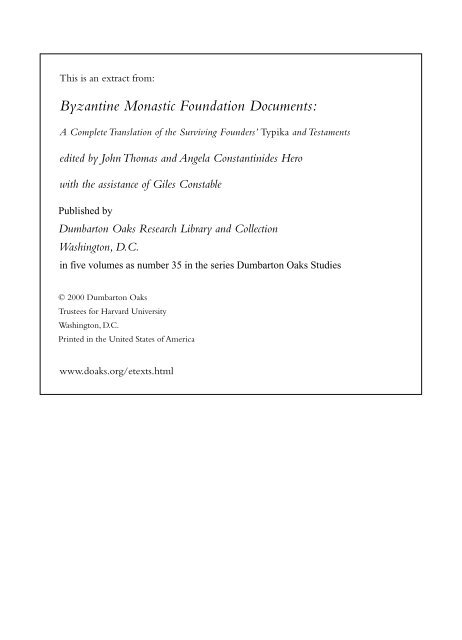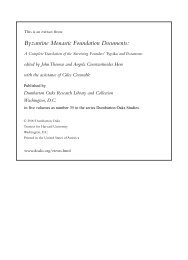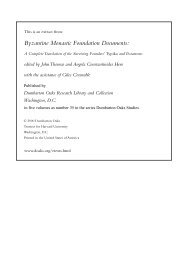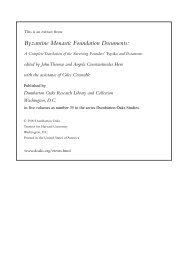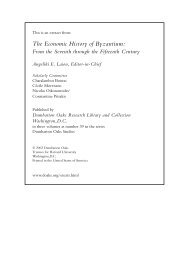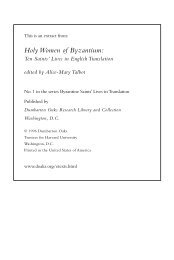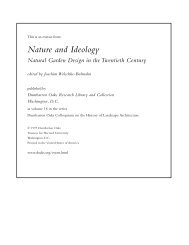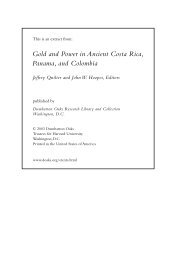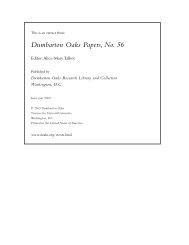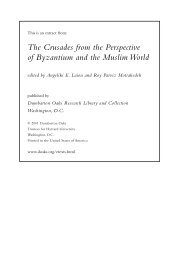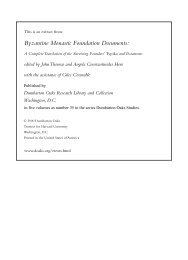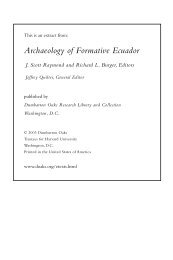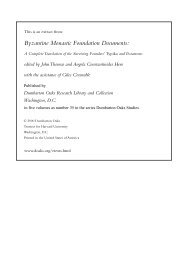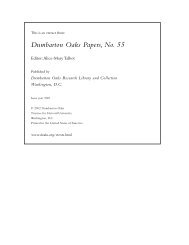3. Theodore Studites - Dumbarton Oaks
3. Theodore Studites - Dumbarton Oaks
3. Theodore Studites - Dumbarton Oaks
Create successful ePaper yourself
Turn your PDF publications into a flip-book with our unique Google optimized e-Paper software.
This is an extract from:<br />
Byzantine Monastic Foundation Documents:<br />
A Complete Translation of the Surviving Founders’ Typika and Testaments<br />
edited by John Thomas and Angela Constantinides Hero<br />
with the assistance of Giles Constable<br />
Published by<br />
<strong>Dumbarton</strong> <strong>Oaks</strong> Research Library and Collection<br />
Washington, D.C.<br />
in five volumes as number 35 in the series <strong>Dumbarton</strong> <strong>Oaks</strong> Studies<br />
© 2000 <strong>Dumbarton</strong> <strong>Oaks</strong><br />
Trustees for Harvard University<br />
Washington, D.C.<br />
Printed in the United States of America<br />
www.doaks.org/etexts.html
<strong>3.</strong> THEODORE STUDITES<br />
<strong>3.</strong> <strong>Theodore</strong> <strong>Studites</strong>: Testament of <strong>Theodore</strong> the Studite for the Monastery<br />
of St. John Stoudios in Constantinople<br />
Date: 826 1<br />
Translator: Timothy Miller<br />
Edition employed: PG 99, cols. 1813–24 = J. J. Sirmond, Opera varia, ed. J. de la Baume, vol. 5:<br />
Sancti Theodori Studitae Epistolae aliaque scripta dogmatica (Paris, 1696), pp. 80–88.<br />
Manuscript: Parisinus graecus 891 (1136 A.D.) 2<br />
Other translations: Latin, by Sirmond, Opera varia, vol. 5, pp. 80–88, reprinted in PG 99, cols.<br />
1814–23; Bulgarian (partial), by I. Goshev, “Pravilata na Studijskija monastir. Vvod, tekst i<br />
izjasnenija,” Godishnik na Sofiiskiya Universitet VI. Bogoslovski Fakultet 17 (1939–40), 5–75,<br />
with translation at 17–21 and commentary at 21–24.<br />
Institutional History<br />
A. Foundation of the Monastery<br />
The Monastery of St. John the Forerunner Stoudios can be traced back to its foundation by a<br />
private benefactor, a certain Stoudios who was consul in 454. 3 Mango (“Studius Basilica,” p. 122)<br />
has shown that the monastery church (katholikon)—reportedly founded on the site of an earlier<br />
parochial church—was built before 454, possibly in 453 or, as recent archaeological evidence<br />
suggests, as early as 450. 4 This church, which survives today as a ruin in Istanbul—the city’s<br />
oldest remaining ecclesiastical building of any size—is to be found in the southwestern corner of<br />
the old city in the former Psamathia region, near the Golden Gate. The church may have been<br />
built, as Mango suggests, in the anticipation of serving as the reliquary for the head of St. John<br />
that contemporaries believed had been discovered in 453 in Emesa, though the new foundation<br />
did not succeed in gaining this valued relic.<br />
A few years later, perhaps in 460, Stoudios installed a group of the “sleepless monks”<br />
(akoimetoi), famous for their continuous liturgical services throughout the entire day, at a monastery<br />
attached to the church. 5 Monks observing this usage continued to staff the monastery down to<br />
the end of the eighth century, except perhaps for a decade or more after the iconoclast Emperor<br />
Constantine V (741–775) expelled the capital’s iconodule monks in 765. 6 The names of some of<br />
the monastery’s superiors are known, and there are a few incidental historical references, but the<br />
monastery did not play an important role in Byzantine ecclesiastical history for the first three<br />
hundred years of its existence. 7<br />
B. <strong>Theodore</strong> the Studite<br />
The foundation achieved prominence when in 798 or 799 the iconodule Empress Irene summoned<br />
our author, <strong>Theodore</strong>, then director with his uncle Plato of a private family monastery at Sakkoudion<br />
[ 67 ]
NINTH CENTURY<br />
in Bithynia, to Constantinople to assume the leadership of the Stoudios monastery, where fewer<br />
than ten of the sleepless monks had survived the iconoclast persecution. 8 The constitutional status<br />
of the monastery at this point is obscure. It may well have been seized by the imperial government<br />
under Constantine V, which a grant by Irene to <strong>Theodore</strong> at this time would seem to suggest. In<br />
any event, <strong>Theodore</strong> chose to treat Stoudios as a private foundation, analogous to Sakkoudion—<br />
which continued in operation—as well as at least three other monasteries then under his control. 9<br />
As Kazhdan has noted (“<strong>Theodore</strong>,” p. 2045), <strong>Theodore</strong>’s intent, only partially realized, to be<br />
sure, was to create “an independent monastic organization able to resist imperial coercion.” Desirable<br />
as this goal must have seemed to iconodule patrons, many of whose foundations had been<br />
confiscated or even secularized under Iconoclasm, it proved impossible of attainment during<br />
<strong>Theodore</strong>’s lifetime, though the number of monks submitting to his authority is said to have ranged<br />
as high as 700–1000, apparently including those resident in the dependent houses (metochia) as<br />
well as at Stoudios itself. 10<br />
<strong>Theodore</strong> was a principled but also a highly contentious personality. He had generally bad<br />
relations with most of the Byzantine rulers after Irene. Even the iconodule Emperor Nikephoros I<br />
(802–811) was no exception, for he carried out the exile of the Studite leadership to the Princes’<br />
Islands decreed by a church synod in 809 after <strong>Theodore</strong> refused to be reconciled to Patriarch<br />
Nikephoros I (806–815) in the Moechian controversy. 11 Dobroklonsky (Prepodobnii Theodor,<br />
vol. 1, p. 652) suggested that the resentment by other superiors of the monastic reforms <strong>Theodore</strong><br />
was promoting (for which see the discussion below in (4) Stoudios, The Studite Monastic Reform)<br />
may have been a factor in the Studite superior’s downfall. <strong>Theodore</strong> was able to maintain a lively<br />
correspondence with various individual members of his monastic communities (which had been<br />
dispersed by the authorities) throughout this period of exile, which came to an end after the accession<br />
of Michael I (811–813). 12<br />
<strong>Theodore</strong> was exiled again in 815 after refusing to acquiesce in a revival of Iconoclasm under<br />
Emperor Leo V (813–820). 13 Just before his departure, <strong>Theodore</strong> divided his monks into small<br />
groups and recommended that they disperse so as to avoid governmental pressure. Stoudios was<br />
reopened in <strong>Theodore</strong>’s absence, however, by the renegade monk Leontios, who thenceforth served<br />
as the monastery’s superior. 14 Most likely <strong>Theodore</strong> never regained control of the Stoudios monastery.<br />
Finding himself in strict confinement under the watchful eye of the metropolitan of Smyrna<br />
from 819 to 821, <strong>Theodore</strong> wrote a letter in the form of a last testament in 819. 15 Though <strong>Theodore</strong><br />
was freed and recalled to Constantinople in 821 after Michael II (820–829) became emperor, he<br />
was unable to reach an accommodation with the new ruler. 16 Instead, he seems to have gone<br />
voluntarily into exile again, probably in 823, first to the peninsula of St. Tryphon near Cape<br />
Akritas southeast of the city, and later to Prinkipo in the Princes’ Islands. 17 He died there in<br />
November, 826, after having gotten his disciple and chosen successor Naukratios to write down<br />
his final Testament, which is translated here. 18<br />
C. <strong>Theodore</strong>’s Immediate Successors<br />
It is unlikely that <strong>Theodore</strong>’s successors were able to return to the Stoudios monastery until after<br />
the death of the last iconoclast Emperor Theophilos (829–842). Shortly thereafter, the translation<br />
of the remains of <strong>Theodore</strong> and his brother Joseph from their original burial site on Prinkipo to<br />
[ 68 ]
<strong>3.</strong> THEODORE STUDITES<br />
Stoudios took place on January 26, 844. 19 True to his teacher’s ways, Naukratios (superior, 842–<br />
47) quarreled with the new orthodox Patriarch Methodios I (843–47) even though the latter’s<br />
iconodule credentials were impeccable. Details are available from the hagiographic life of<br />
Naukratios’ successor Nicholas the Studite (superior, 847–50 and 853–858). 20 This source also<br />
supplies us with the names of several other Studite superiors of the mid-ninth century as well as a<br />
discussion of Nicholas’ refusal to accept Photios (858–67) as patriarch, preferring as he did to<br />
remain loyal to the deposed Ignatios (847–58).<br />
D. Stoudios as an Imperial Monastery<br />
In the early tenth century, during the final years of the reign of Leo VI (886–912), Stoudios seems<br />
to have changed over from its traditional oppositionist posture to being a predictable supporter of<br />
imperial authority, whose superiors and other high officials were entrusted by the emperors with<br />
many important missions, such as the Studite monk Euthymios whom Emperor John I Tzimiskes<br />
(969–976) sent to Mount Athos to adjudicate disciplinary problems, a mission that resulted in the<br />
issuance of (12) Tzimiskes (see below, Chapter Two). Also, beginning in 902 when Leo VI expelled<br />
Leo Musikos from the palace and had him imprisoned at Stoudios, the monastery came to<br />
serve the convenience of the emperors for this purpose as well, down into the 1070s. 21 In the<br />
eleventh century, three former emperors were sent into exile at Stoudios: Michael V Kalaphates in<br />
1042, Isaac I Komnenos in 1059, and Michael VII Doukas in 1078. 22 The monastery’s ability to<br />
supply three patriarchs of Constantinople, Antony III (974–979), Alexios <strong>Studites</strong> (1025–1043),<br />
and Dositheos (1189–1191), also testifies to its intimate connections with the imperial government.<br />
Therefore, it appears likely on circumstantial evidence that Stoudios had been an imperial<br />
monastery since circa 900, and perhaps considerably earlier.<br />
E. Stoudios in the Last Centuries of the Empire<br />
The monastery was quiescent during the Komnenian era and does not appear to have played an<br />
active part in the Evergetian monastic reform movement as it progressed throughout the late eleventh<br />
and twelfth centuries. Stoudios lost part of its relics during the Latin conquest of Constantinople<br />
in 1204, and was left abandoned in a neighborhood that became a sheep pasture. In 1293, Constantine<br />
Palaiologos, a brother of Emperor Andronikos II (1282–1328), restored the monastery by putting<br />
a new roof on the church, shoring up its walls, and recruiting new monks. 23 By the late fourteenth<br />
century, Stoudios ranked once again as the most honored monastery in Constantinople. 24 The<br />
monastery and its superiors continued to play an active part in Byzantine history right up to the<br />
fall of Constantinople to the Turks in 1453, at which time, however, the monks were likely dispersed<br />
and the foundation’s thousand-year history as a monastery came to an end. 25<br />
F. Conversion of the Church into a Mosque in Ottoman Times<br />
Sultan Beyazid II (1481–1512) granted the buildings on the site to the Albanian Ilyâs (Elias) bey<br />
b. Abdullah, his imrahor or “stable-master,” who converted the church into a mosque, which has<br />
henceforth been known as Imrahor or Mirahor Camii. 26 Evidently most of the monastery soon<br />
disappeared, since the traveler Peter Gilles found no trace of it during his visit to the site in the<br />
mid-sixteenth century. A fire that swept the old Psamathia neighborhood in 1782 damaged the<br />
[ 69 ]
NINTH CENTURY<br />
mosque severely, but it was rebuilt in 1820. After an earthquake struck in 1894, the building fell<br />
into ruins.<br />
G. Archaeological Evidence from the Site<br />
Although no adequate excavation of the site or survey of the building has ever been completed,<br />
the Russian Archaeological Institute in Constantinople under Panchenko cleared the site, excavated<br />
a fifth-century crypt under the sanctuary, and made some preliminary observations in 1907–<br />
1909. 27 A few years later, Ebersolt and Van Millingen both published some plans before another<br />
fire damaged the remains further in 1920. 28 It has been determined that the monastery must have<br />
been located along the south side of the church’s atrium, but only a cistern remains from that part<br />
of the foundation. 29 Old photographs, however, show that there was once a two-columned groinvaulted<br />
chapel of middle or late Byzantine construction located over the corner of the cistern that<br />
must have been preserved down to the nineteenth century. 30<br />
Analysis<br />
Judging from the large number of provisions it shares with an earlier letter of <strong>Theodore</strong>’s to his<br />
disciple Nicholas, <strong>Theodore</strong>’s Testament must be considered a final copy of a work long in gestation.<br />
31 Therefore it should not be seen as reflecting only the reduced circumstances of the author’s<br />
confederation of monasteries at the time of his death in 826, when the Stoudios monastery itself<br />
had been out of his control for over a decade. It is also just one of several important witnesses to<br />
Studite monasticism, for which we have an extraordinary wealth of source material, including the<br />
Studite typikon, (4) Stoudios, the next document in our collection. 32<br />
The Testament illustrates the dramatic development of the testamentary format which took<br />
place in the two hundred years that had elapsed since the composition of (1) Apa Abraham. Unlike<br />
the latter, this testament has a great deal of regulatory content, though it may be considered to fall<br />
a little short of the scope of a typikon, even an early example of the genre like (4) Stoudios written<br />
for <strong>Theodore</strong>’s own foundation after his death. A profession of orthodox faith heads up the document,<br />
a new feature, but one with subsequent parallels (e.g., (7) Latros [1] ff., (10) Eleousa [2],<br />
and (49) Geromeri [2] ff.).<br />
<strong>Theodore</strong> enthusiastically (but vaguely) endorses [13] the patristic “canons and laws,” especially<br />
those of Basil of Caesarea. There is, however, not much explicitly Basilian content in this<br />
document, which is true generally of <strong>Theodore</strong>’s ascetic writings. 33 One readily apparent borrowing,<br />
the endorsement of the teaching of catechism [11], appears to have Pachomian roots, perhaps<br />
through the mediation of unidentified Palestinian ascetic sources of which our author was especially<br />
fond. 34<br />
A. Lives of the Monks<br />
The core of this document is made up of a series of injunctions in the style of the “canons” in the<br />
Syro-Palestinian tradition. The author directs most of his commandments to the superior; there are<br />
only a few general admonitions [25] ff. to the monks. An important theme in the injunctions is the<br />
avoidance of sexual temptations. Perhaps this is a recollection of perils that were more immediate<br />
when the foundation was being directed from the Stoudios monastery in Constantinople. <strong>Theodore</strong><br />
[ 70 ]
<strong>3.</strong> THEODORE STUDITES<br />
is mostly concerned about women in this connection [9], [15], [16], [17], although he also forbids<br />
the superior an adolescent disciple [18], and there is a curious prohibition of female domestic<br />
animals [5] (to be repeated in (13) Ath. Typikon [31] and elsewhere). 35 Maintenance of sexual<br />
segregation evidently was difficult, especially in an urban and aristocratic milieu, and <strong>Theodore</strong><br />
explicitly allows for exceptions [16]. Total segregation (as espoused later by (42) Sabas) was not<br />
thought to be practical.<br />
B. Constitutional Matters<br />
The transmission of the monastery, the principal concern of (1) Apa Abraham, is our author’s first<br />
concern here too after his profession of faith. <strong>Theodore</strong> exercises his patronal right to appoint his<br />
successor (not named, but known to be his disciple Naukratios). Subsequent superiors were to be<br />
chosen by the community, a common arrangement in medieval Byzantium which had the effect of<br />
lessening patronal influence after the next generation (cf. the arrangements in (10) Eleousa [16],<br />
cf. [11]).<br />
An important theme in <strong>Theodore</strong>’s admonitions to the superior is his concern, shared with the<br />
author of (1) Apa Abraham [5], that the superior not permit the monastery’s resources to fall into<br />
the hands of outsiders; to this he adds the injunction that the superior not misuse the monastery’s<br />
property for his own use either [3]. This reflects a strengthening of the notion of institutional<br />
integrity even within the context of private ownership.<br />
It is important to view this document in the context of its association with a private religious<br />
foundation whose claim to independence from state control <strong>Theodore</strong> had been able to uphold<br />
with only partial success during his lifetime. Indeed, he had lost the Stoudios monastery itself,<br />
originally a gift from Empress Irene that her successors felt free to revoke twice, in 809 and in<br />
815. In addition to confiscation, secularization was another threat, particularly during the bitter<br />
iconoclastic controversy in which <strong>Theodore</strong> and his monks had generally stood in opposition to<br />
imperial policy. Even aside from the extraordinary dangers of the times, for a superior of noble<br />
birth, kinship ties posed potential conflicts of interest [8]. The superior is explicitly told not to<br />
prefer eminent and powerful persons to the interests of the community [23].<br />
Philosophically, <strong>Theodore</strong> preferred a consultative to an authoritarian style of rule, if not for<br />
himself (which seems doubtful), then at least for his successors. Accordingly, the superior was to<br />
supervise [22] the performance of the monks in various offices in conjunction with the “foremost<br />
brothers.” Generally speaking, he was not to act [24] in any area without consulting with “those<br />
who are foremost in knowledge and prudence regarding the issue in question.” <strong>Theodore</strong> even<br />
suggests [25] that the community itself is the ultimate source of authority within the institution by<br />
virtue of the fact that the monks have assented to the choice of their leader.<br />
C. Financial Matters<br />
Though there is no direct testimony, it would appear that the monastery itself was supported by the<br />
income from a landed endowment [4], cf. [21], worked, evidently, by free labor, since both agricultural<br />
and personal slaves are explicitly forbidden. Nothing is said about any manual labor<br />
engaged in by the monks, though we know from other sources that monks were engaged in agricultural<br />
labors at the Studite monasteries outside Constantinople, though not at Stoudios itself. 36<br />
[ 71 ]
NINTH CENTURY<br />
The author may have feared to arouse jealousy on account of the monastery’s wealth, for modest<br />
clothing [19] is recommended for the superior and he is instructed not to flaunt the institution’s<br />
wealth [20]. The monastery itself is not to store up gold; charitable distributions are enjoined for<br />
“sharing abundance” [21]. The superior is also ordered not to administer the monastery’s finances<br />
personally, but to appoint officials for this task [24]. This separation of administrative and financial<br />
responsibilities is part of our author’s preference for consultative (as opposed to authoritarian)<br />
rule.<br />
D. Subsequent Influence<br />
Overall, then, this is a distinctive document that is very much a product of the preferences and<br />
concerns of its time despite the author’s stated allegiance to the revival of patristic tradition. It had<br />
the good fortune to be associated with the manuscript tradition of <strong>Theodore</strong>’s popular Small<br />
Catecheses, with the result that it followed that work into wide circulation, particularly in the<br />
twelfth century at the very time that the later Evergetian monastic reform movement was coming<br />
to dominate the empire’s religious life. Yet its earliest impact on the documents in our collection is<br />
to be found on (13) Ath. Typikon in the ninth century, which freely incorporates, generally verbatim,<br />
no less than 18 of the 27 chapters into which we have divided <strong>Theodore</strong>’s Testament. While<br />
there would be no further literal quotations, such Studite institutions as the mandate [22], [24] for<br />
consultative rule and the ban [21] on accumulating cash assets in the monastery would be incorporated<br />
in the constitutions of later Byzantine monasteries.<br />
Notes on the Introduction<br />
1. The Testament was prepared shortly before <strong>Theodore</strong>’s death on November 11, 826; see Naucratii<br />
confessoris encyclica de obitu sancti Theodori Studitae (BHG 1756), PG 99, cols. 1824–49, at 1844B,<br />
cf. Michael the Monk, Vita S. Theodori (Vita B) 66, PG 99, cols. 324D–325A.<br />
2. There are many other witnesses, for the Testament is preserved along with <strong>Theodore</strong>’s popular Small<br />
Catecheses; see Leroy, “Petites Catéchèses,” p. 337, n. 37.<br />
<strong>3.</strong> The standard history, though much dated, remains E. Marin, De Studio, supplemented by B. Panchenko,<br />
“Ha. Ioannes Studios,” IRAIK 14 (1909), 136–52; 15 (1911), 250–57; 16 (1912), 1–359; Alexander<br />
Kazhdan et al., “Stoudios Monastery,” ODB, pp. 1960–61, provide summary accounts of the history of<br />
the monastery.<br />
4. Sources for the foundation are: Anthologia Palatina 1.4, ed. Hugo Stadtmüller (Leipzig, 1894); Suda, ed.<br />
Ada Adler, vol. 4 (Leipzig, 1935), p. 438; <strong>Theodore</strong> Lector, Historia ecclesiastica 384, ed. G. C. Hansen<br />
(Berlin, 1971), p. 108; cf. Theophanes, Chronographia, a.m. 463, ed. Karl de Boor, vol. 1 (Leipzig,<br />
1883–85), p. 11<strong>3.</strong> For archaeological evidence from brick stamps, see Urs Peschlow, “Die Johanneskirche<br />
des Studios in Istanbul,” JÖB 32.4 (1982), 429–34.<br />
5. For the akoimetoi, see General Bibliography, X. Early Constantinopolitan Monasticism.<br />
6. Theophanes, Chronographia a.m. 765, ed. de Boor, pp. 443–45; Frazee, “St. <strong>Theodore</strong>,” p. 31; Janin,<br />
Géographie, vol. 3, p. 430.<br />
7. For a list of superiors, see Janin, Géographie, vol. 3, p. 432.<br />
8. Vita B 19–20, PG 99, cols. 257B–260A, and “<strong>Theodore</strong> of Studium, Laudatio Platonis 32, PG 99, cols.<br />
833D–836A; for the date, which cannot be precisely determined, see Henry, “<strong>Theodore</strong>,” p. 47. Leroy,<br />
“Réforme,” pp. 202, 205, rejects the traditional view that the move to the capital was motivated by the<br />
appearance of Arab raiders in Bithynia as mentioned in Theophanes, Chronographia a.m. 799, ed. de<br />
Boor, p. 47<strong>3.</strong><br />
[ 72 ]
<strong>3.</strong> THEODORE STUDITES<br />
9. Leroy, “Réforme,” p. 206, nn. 191–9<strong>3.</strong><br />
10. Vita B 20, PG 99, col. 260C (1000 monks); Theophanes, Chronographia a.m. 806, ed. de Boor, p. 481<br />
(700 monks); rightly qualified by Henry, “<strong>Theodore</strong>,” p. 49, Kazhdan et al., “Stoudios Monastery,” p.<br />
1960, and Leroy, “Réforme,” p. 206, n. 200.<br />
11. Vita B 27, PG 99, col. 269; Theophanes, Chronographia a.m. 809, ed. de Boor, p. 484; Frazee, “St.<br />
<strong>Theodore</strong>,” p. 47; Henry, “<strong>Theodore</strong>,” pp. 64–65.<br />
12. Henry, “<strong>Theodore</strong>,” p. 66, n. 1, based on Dobroklonsky, Prepodobnii Theodor, vol. 1, p. 671, reports 22<br />
surviving letters from this period, with another 180 now lost. Notable among the surviving letters is<br />
one edited by R. Devreesse, “Une lettre de s. Théodore Studite relative au synode moechien (809),” AB<br />
68 (1950), 44–57, that was addressed to Basil, superior of the monastery of St. Sabas in Jerusalem. For<br />
<strong>Theodore</strong>’s recall to Constantinople, probably in 812 (so Grumel, Regestes, no. 387), see Laud. Plat.<br />
40, PG 99, col. 844C, and Vita B 28, PG 99, cols. 272D–273A, with Henry, “<strong>Theodore</strong>,” p. 68.<br />
1<strong>3.</strong> Vita B 37, PG 99, col. 288B, with Henry, “<strong>Theodore</strong>,” p. 81; Frazee, “St. <strong>Theodore</strong>,” p. 48, and J.<br />
Pargoire, “La Bonita de s. Théodore Studite,” EO 6 (1903), 207–1<strong>3.</strong><br />
14. Vita A 40–41, PG 99, cols. 196–97.<br />
15. Ep. 22, ed. Georgios Fatouros, Theodori Studitae epistulae, vol. 1 (Berlin-New York, 1992), pp. 57–62,<br />
with Henry, “<strong>Theodore</strong>,” p. 8<strong>3.</strong><br />
16. Vita B 48, PG 99, col. 304; Frazee, “St. <strong>Theodore</strong>,” p. 49; Henry, “<strong>Theodore</strong>,” pp. 84–87, who at 88, n.<br />
1, following Dobroklonsky, Prepodobnii Theodor, vol. 1, p. 859, n. 5, is surely right to challenge<br />
Gardner, <strong>Theodore</strong>, p. 197, 199, in her assertion that <strong>Theodore</strong> temporarily regained Stoudios at this<br />
time.<br />
17. Frazee, “St. <strong>Theodore</strong>,” p. 49; Henry, “<strong>Theodore</strong>,” p. 88.<br />
18. Naukratios, Encyclica de obitu s. Theodori Studitae, PG 99, cols. 1824–49; Vita B 66, PG 99, 324D–<br />
325A; with Frazee, “St. <strong>Theodore</strong>,” p. 49, and Henry, “<strong>Theodore</strong>,” p. 90.<br />
19. See Van der Vorst, “Translation.”<br />
20. Vita s. Nicolae Studitae, PG 105, cols. 863–926; for a list of the superiors, see Janin, Géographie, vol. 3,<br />
p. 43<strong>3.</strong><br />
21. For details and references to the sources, see Janin, Géographie vol. 3, p. 437.<br />
22. For details and references, see Janin, Géographie, vol. 3, p. 427, with Kazhdan et al., “Stoudios Monastery,”<br />
p. 1960.<br />
2<strong>3.</strong> Nikephoros Gregoras, Byzantina historia 6.5, ed. L. Schopen and I. Bekker, CSHB, vol. 1 (Bonn, 1829–<br />
55), p. 190; Janin, Géographie, vol. 3, p. 432; Müller-Wiener, Bildlexikon, pp. 149–50.<br />
24. See Darrouzès, Regestes, vol. 1, pt. 6 (Paris, 1979), no. 2714 (March 1381) = MM 2, p. 22, with Janin,<br />
Géographie, vol. 3, p. 431, and Kazhdan et al., “Stoudios Monastery,” p. 1960.<br />
25. For details and references, see Janin, Géographie, vol. 3, p. 432.<br />
26. Janin, Géographie, vol. 3,. p. 432; Müller-Wiener, Bildlexikon, p. 150.<br />
27. Results published in Panchenko, “Ha. Ioannes <strong>Studites</strong>” see comments by Mathews, Early Churches,<br />
pp. 19–20, and Byzantine Churches, p. 14<strong>3.</strong><br />
28. Ebersolt and Thiers, Églises, pp. 3–18; Van Millingen, Byzantine Churches, pp. 35–61.<br />
29. Mathews, Early Churches, p. 22.<br />
30. Mathews, Byzantine Churches, p. 144.<br />
31. Ep. 10, ed. Fatouros, vol. 1, pp. 31–34, with cross-references to (3) <strong>Theodore</strong> <strong>Studites</strong> in the Document<br />
Notes below.<br />
32. For a discussion of the other sources for Studite monasticism, see below (4) Stoudios, The Studite<br />
Monastic Reform Movement.<br />
3<strong>3.</strong> See Leroy, “Influence,” p. 491.<br />
34. See the Pachomian Precepts and Institutes [15], ed. A. Boon, Pachomiana Latina (Louvain, 1932), p.<br />
57, and trans. A. Veilleux, Pachomian Koinonia, vol. 2 (Kalamazoo, Mich., 1981), p. 171; for <strong>Theodore</strong>’s<br />
partiality to Palestinian sources, especially Dorotheos of Gaza, see Leroy, “Réforme,” pp. 188–90.<br />
[ 73 ]
NINTH CENTURY<br />
35. See also (12) Tzimiskes [22], [23]; (15) Constantine IX [3].<br />
36. See Leroy, “Réforme,” p, 204, with references in nn. 185–86, and “Vie,” p. 37, n. 2, cf. p. 39, n. 1.<br />
Biography of the Author<br />
A. Hagiography<br />
Halkin, François, Bibliotheca hagiographica graeca, 3rd ed. (Brussels, 1957), 1754, 1755, 1755d.<br />
Latyschev, B., “Vita S. Theodori Studitae in codice Mosquensi musei Rumianzoviani no. 520,” V V 21<br />
(1914), 255–304 (Vita C).<br />
Michael the Monk, Vita S. Theodori (Vita B), PG 99, cols. 233–328.<br />
Vita S. Theodori (Vita A), PG 99, cols. 113–232.<br />
B. Secondary Works<br />
Dobroklonsky, A., Prepodobnii Theodor, ispododnik i igumen Studiiskii, 2 vols. (Odessa, 1913–14).<br />
Fatouros, Georgios, Theodori Studitae epistulae, 2 vols. (Berlin-New York, 1992), with discussion of<br />
<strong>Theodore</strong>’s life and work in vol. 1, pp. 3–38.<br />
Frazee, Charles, “St. <strong>Theodore</strong> of Studios and Ninth Century Monasticism in Constantinople,” Studia<br />
monastica 23 (1981), 27–58.<br />
Gardner, Alice, <strong>Theodore</strong> of Studium, His Life and Times (London, 1905).<br />
Hausherr, I., S. Théodore Studite, l’homme et l’ascète (d’après ses catéchèses), OC 6 (1926), 1–87.<br />
Henry, Patrick, “<strong>Theodore</strong> of Studios: Byzantine Churchman” (Ph.D. diss., Yale University, 1968).<br />
Hermann, Basilius, “Der hl. Abt Theodor, der asketische Meister von Studium und die Studitenmönche,”<br />
ZAM 4 (1929), 289–312; 5 (1930), 121–46.<br />
———, “Der hl. Abt Theodor von Studium (+ 11. Nov. 826), Erneuerer des basilianischen Mönchtums, im<br />
Lichte seiner Schriften,” BM 7 (1925), 418–38.<br />
Kazhdan, Alexander, “<strong>Theodore</strong> of Stoudios,” ODB, pp. 2044–45.<br />
Leroy, Julien, “Saint Théodore Studite,” in Théologie de la vie monastique (Paris, 1961), pp. 423–36.<br />
Marin, E., St. Théodore Studite (759–826) (Paris, 1906).<br />
Schiwietz, S., De S. Theodoro Studita reformatore monachorum Basilianorum (diss., Breslau, 1896).<br />
Schneider, G. A., Der hl. Theodor von Studion, sein Leben und Wirken (Münster, 1900).<br />
Papadopoulos, Chr., “Ho hagios Theodoros Stoudites en to agoni autou hyper ton hieron eikonon,” EEBS 15<br />
(1939), 3–37.<br />
Thomas, C., Theodor von Studion und sein Zeitalter (Leipzig, 1892).<br />
Bibliography<br />
Beck, Hans-Georg, Kirche und Theologische Literatur im Byzantinischen Reich (Munich, 1959), pp. 491–<br />
95, esp. 494.<br />
Ebersolt, J., and Thiers, A., Les églises de Constantinople (Paris, 1913), pp. 3–18.<br />
Hermann, Basilius, “Eucharistische Sitten im Leben des Hl. Theodor <strong>Studites</strong>,” Liturgie und Kunst 4 (1923),<br />
76–80.<br />
Janin, Raymond, La géographie ecclésiastique de l’empire byzantin, vol. 3: Les églises et les monastères<br />
[de Constantinople], 2nd ed. (Paris, 1969), pp. 430–40.<br />
Kazhdan, Alexander, Talbot, Alice-Mary, and Cutler, Anthony, “Stoudios Monastery,” ODB, pp. 1960–61.<br />
Leroy, Julien, “L’influence de saint Basile sur la réforme studite d’après les Catéchèses,” Irénikon 52 (1979),<br />
491–506.<br />
———, “Les Petites Catéchèses de s. Théodore Studite,” Le Muséon 71 (1958), 329–58.<br />
———, “La réforme studite,” OCA 153 (1958), 181–214.<br />
———, “Un témoin ancien des Petites Catéchèses de Théodore Studite,” Scriptorium 15 (1961),<br />
36–60.<br />
[ 74 ]
<strong>3.</strong> THEODORE STUDITES<br />
———, “La vie quotidienne du moine studite,” Irénikon 27 (1954), 21–50.<br />
Mango, Cyril, “The Date of the Studius Basilica at Istanbul,” B&MGS 4 (1978), 115–22.<br />
Marin, E., De Studio, coenobio Constantinopolitano (Paris, 1897).<br />
Mathews, Thomas, The Byzantine Churches of Istanbul: A Photographic Survey (University Park, Pa., 1976),<br />
pp. 143–58.<br />
———, The Early Churches of Constantinople: Architecture and Liturgy (University Park, Pa., 1971), pp.<br />
19–27.<br />
Müller-Wiener, Wolfgang, Bildlexikon zur Topographie Istanbuls (Tübingen, 1977), pp. 147–52.<br />
Panchenko, B., “Ha. Ioannes Studios,” IRAIK 14 (1909), 136–52; 15 (1911), 250–7; 16 (1912), 1–359.<br />
Pargoire, Jules, “Une loi monastique de St. Platon,” BZ 8 (1899), 98–101.<br />
Van Millingen, A., Byzantine Churches in Constantinople, Their History and Architecture (London, 1912),<br />
pp. 35–61.<br />
Vorst, Ch. Van de, “La Petite Catéchèse de St. Théodore Studite,” AB 33 (1914), 31–51.<br />
———, “La translation de S. Théodore Studite et de S. Joseph de Thessalonique,” AB 32 (1913),<br />
27–62.<br />
Werner, E., “Die Krise im Verhältnis von Staat und Kirche in Byzanz: Theodor von Studion,” Berliner<br />
byzantinische Arbeiten 5 (1957), 113–3<strong>3.</strong><br />
Translation<br />
The Testament of our father, the holy, inspired confessor <strong>Theodore</strong>, the Studite superior, which<br />
was read aloud before his final repose.<br />
[Preface]<br />
Since this wretched body of mine has fallen into a constant state of ill health and I am unable to<br />
summon all of you—my sons, brothers, and fathers—at the time of my departure because the<br />
monasteries are located in diverse places and especially because some of you have journeyed afar<br />
on business, I have heeded the words of the sacred David, “I prepared myself and was not terrified”<br />
(Ps. 118 [119]:60); and again, “My heart is ready” (Ps. 56 [57]:7). Since the hour of my<br />
passing out of this life has already arrived, I have hastened to draw up this Testament beforehand.<br />
I thought that this was a fitting and sure method for you to hear my final utterance and discern<br />
exactly what I believe and think, and what sort of person I leave as a superior to succeed me so that<br />
you might thus enjoy harmony and peace in Christ—that peace which the Lord left to his holy<br />
disciples and apostles as he was about to return to the heavens.<br />
Concerning Faith 1<br />
Therefore, I believe in the Father and the Son and the Holy Spirit—the holy and consubstantial<br />
and primal Trinity, [in whose name] I was baptized and regenerated and perfected. I confess God<br />
the Father, God the Son and God the Holy Spirit—the three are one with respect to divinity just as<br />
conversely the one is three with respect to individual persons. For the Trinity is one God according<br />
to substance although it is divided by the distinction of persons. I also confess that one of the<br />
Trinity, our Lord Jesus Christ, came into the flesh out of immeasurable charity, that is to say for<br />
the salvation of our race, having assumed the flesh from the holy and blameless Mother of God.<br />
[ 75 ]
NINTH CENTURY<br />
He was born of her womb in accordance with the law of nature save for human procreation as the<br />
divine prophecy had foretold. This same Christ is dual [in nature], whole and complete in his<br />
divinity so that that which he was suffered no change, and whole and complete in his humanity so<br />
that that which he assumed lacked nothing. The same Christ is one in person as he is made manifest<br />
in two natures. So also he is manifest in two wills and two energies through which he acted in<br />
accordance with both things divine and things human. [col. 1816]<br />
In addition, I follow the six holy and ecumenical councils and reject every error of heretical association.<br />
I also follow the Second Council of Nicaea which was recently assembled against the<br />
accusers of Christ. I accept and revere the sacred and holy images of our Lord Jesus Christ, of the<br />
Mother of God, of the apostles, prophets, martyrs, and of all the holy and just. Moreover, I ask for<br />
their undefiled intercessions to propitiate the Godhead. With faith and awe I embrace their allholy<br />
relics as full of divine grace.<br />
I also accept every God-inspired book of the Old and New Testaments as well as the biographies<br />
and divine writings of all the holy fathers, teachers, and ascetics. I say this on account of the<br />
crazed Pamphilos who has come from the East attacking these holy people—I mean Mark, Isaiah,<br />
Barsanouphios, Dorotheos, and Hesychios 2 —but not the Barsanouphios, Isaiah, and Dorotheos<br />
who belonged to the fellowship of the headless ones 3 and had the same number of horns as did the<br />
ten-horned one, 4 for these men were anathematized by the saintly Sophronios in his booklet. 5<br />
These last individuals are obviously different from those aforementioned men whom I accept as<br />
part of the patristic tradition after having questioned the patriarch Tarasios, 6 who recently held the<br />
office of bishop [of Constantinople], and other trustworthy men, both natives and Easterners.<br />
Moreover, the image of Barsanouphios was placed on the sacred altar covering of the Great Church<br />
together with the holy fathers, Antony, Ephraem, and others. 7 Also, I have found no impiety in<br />
their teachings, but on the contrary, much of spiritual assistance. I will accept them until some<br />
charge against them has been proven by a synodal inquiry. For, if these very men should appear<br />
worthy of anathema or others whom they have led to heresy, may they be anathematized and<br />
cursed, totally anathematized from the Father, the Son, and the Holy Spirit.<br />
In addition, I acknowledge that the monastic life is lofty and exalted, even angelic, pure of<br />
every sin on account of its perfect way of life. It is clear that the monastic life must be ordered<br />
according to the ascetic rules of the holy Basil the Great and not by half measures so that some in<br />
one place choose some rules and let others go. For, one cannot choose to lead this life lawfully in<br />
some other fashion without the three revealed orders of the divine ladder. 8 Nor is it possible to<br />
own a slave or a domesticated animal of the female sex because this would be alien to the religious<br />
profession and dangerous to souls. 9 I have treated such things cursorily since there is not time to<br />
explain them fully, but only to prevent some from holding an inferior opinion of me contrary to<br />
what I truly think and believe. [col. 1817]<br />
Concerning the Superior<br />
Having treated of these points in this way, I shall speak in second place about the superior. Now as<br />
the first one I leave the lord, my father as well as yours, the most holy recluse and father who is<br />
[ 76 ]
<strong>3.</strong> THEODORE STUDITES<br />
both a luminary and a teacher. This man has been set before both you and me in the Lord and is<br />
established as the head even though he has removed himself to perfect his humility in solitude by<br />
imitating Christ. Through his directions and prayer I trust that you will be saved, if indeed on your<br />
part you show him attentive and ready obedience. Thereafter, elect someone by a common vote in<br />
a godly fashion and in the manner which the fathers have established, for my desire is to support<br />
whomever the community finds suitable.<br />
But now, my father and brother, whoever you are, before God and his chosen angels I entrust all<br />
the community in Christ to you so that you may receive it. But, how should you accept? In what<br />
grand manner should you guide them? In what fashion should you guard them? As the lambs of<br />
Christ! As your own dear limbs! Cherish and respect them, loving each one of them with an equal<br />
measure of charity since each man cherishes the limbs of his body equally. 10 Open your heart in<br />
sympathy, welcome them all in mercy. Nurse them, reform them, make them perfect in the Lord.<br />
Sharpen your understanding with prudence; rouse your will with courage; make your heart steadfast<br />
in faith and hope. Lead them forward in every good work. Defend them against spiritual<br />
enemies. Shield them, regulate them. Introduce them to the place of virtue. Distribute shares in the<br />
land of tranquility. Therefore, I give you these rules which of necessity you ought to uphold.<br />
Rules for the Superior<br />
1. Therefore, save for grave necessity, you shall not alter at all the constitution and rule which you<br />
have received from my lowliness.<br />
2. You shall not possess anything of this world nor store up anything for yourself as your own, not<br />
even one piece of silver.<br />
<strong>3.</strong> You shall not divide your soul and heart by attachments and cares other than for those whom<br />
God has entrusted to you and I have handed over, those who have become your spiritual sons and<br />
brothers. You shall not use the things of your monastery for those who were at one time yours<br />
according to the flesh—either for your relatives or friends or associates. Neither in life nor after<br />
death shall you do this for these aforementioned people—neither according to the requirements of<br />
charity nor the rules of heredity. For you are not from those of the world so that you have to share<br />
with those of the world. But if some should cross over from the life of society to our order, then<br />
you should take thought for them in imitation of the holy fathers.<br />
4. You shall not possess a slave either for your own use or for your monastery or for the fields<br />
since man was created in the image of God. This institution has been allowed only to those in<br />
worldly life just as marriage is. It is necessary for you rather to dedicate yourself spiritually as a<br />
slave to your brothers of the same spirit, [col. 1820] even though when appearing in public you are<br />
reckoned their lord and teacher.<br />
5. For necessary duties you shall not have an animal from among those of the female race since<br />
you have renounced completely the female sex. You shall not have one either in the monastery or<br />
in the fields as no one of our holy fathers did nor does nature herself allow it.<br />
6. You shall not ride on horses or mules when not necessary; rather you shall travel by foot in<br />
[ 77 ]
NINTH CENTURY<br />
imitation of Christ. If it should be necessary, however, let your beast of burden be a colt.<br />
7. You shall always be vigilant that all things in the community be held in common and be indivisible<br />
and that nothing be owned on the part of any individual, not even a needle. Your body and<br />
your soul, nothing else, should be divided up for all your spiritual children and brothers in the<br />
impartiality of love.<br />
8. As a fugitive from the world and from marriage, you should have no part of adopting those of<br />
the world as brothers or engaging in spiritual relationships 11 with them since such practices are<br />
not found in the fathers, or if they have been found, then only rarely so that they do not constitute<br />
a law.<br />
9. You shall not dine with women other than your mother according to the flesh and your sister,<br />
whether these be women in religious life or lay persons. I do not permit this unless some pressure<br />
or necessity should require it as the holy fathers warn.<br />
10. You should not go out frequently or roam about unnecessarily, leaving your own flock. For, it<br />
is desirable that you have time to spend with the flock and be able to save these sheep endowed<br />
with reason, but most wily and given to straying.<br />
11. You shall always be on your guard to teach catechism three times a week in the evening either<br />
by your own agency or through another of your children since this is the salutary tradition of the<br />
fathers.<br />
12. You should not grant what they call the little habit and after that the great one, for the habit like<br />
baptism is one according to the usages of the fathers.<br />
1<strong>3.</strong> You should not transgress the laws and canons of the holy fathers, above all those of the holy<br />
and great Basil. Whatever you do or say, you should do it in accord with the testimony of the<br />
Scriptures or of patristic custom without violating the command of God.<br />
14. You shall not leave your flock and transfer to another one or return to an office without the<br />
approval of your own community.<br />
15. You shall not have a friendship with a woman in religious life nor enter into a women’s monastery.<br />
Nor shall you speak alone with a nun or a woman of the world unless necessity at some<br />
time compels you and then with two persons from either party present since one person is easily<br />
influenced as they say.<br />
16. You shall not open the door of the monastery for any woman at all to enter unless it is absolutely<br />
necessary. If you are able to meet discreetly, this opportunity should not be rejected.<br />
17. You shall not make for yourself a lodging or a secular house for your spiritual children in<br />
which there are women and go there frequently. [col. 1821] Rather you shall choose to attend to<br />
your temporary and essential needs at the home of pious men.<br />
18. You shall not have an adolescent disciple in your cell out of affection, but you shall be served<br />
by various brothers and by a person above suspicion.<br />
[ 78 ]
<strong>3.</strong> THEODORE STUDITES<br />
19. You shall not possess very distinctive and expensive clothing besides the priestly vestments.<br />
Rather, you shall put on humble clothes and shoes in imitation of the fathers.<br />
20. You shall not spend lavishly either for your own lifestyle or for the reception of guests. This<br />
will distract you since it belongs to a life devoted to pleasure.<br />
21. You shall not store up gold in your monastery, but you should share your abundance of whatever<br />
sort with those in need at the portal of your court as the holy fathers did.<br />
22. You shall not take charge of the treasury room nor assume the cares of stewardship, but let<br />
your key be the greatest care of souls, of loosing and binding according to the Scriptures (cf. Matt.<br />
16:19). You shall entrust the gold and other necessities to the stewards, the cellarers, and as seems<br />
appropriate to each service, all under your manifest authority. Together with the foremost brothers,<br />
you can take an account of each administration and transfer the offices to whichever person<br />
you decide.<br />
2<strong>3.</strong> You shall not place the person of any other man, eminent and powerful according to the present<br />
age, ahead of that which benefits the community. Nor shall you shrink from laying down your life<br />
even to the point of bloodshed in guarding these godly laws and commands.<br />
24. You shall not make or do anything according to your own opinion whether regarding a spiritual<br />
or a physical matter of any kind. First, you should not act without the advice and prayer of<br />
your lord and father; second, without the advice of those who are foremost in knowledge and<br />
prudence regarding the issue in question. For there is need of one advisor or perhaps two, three, or<br />
more as the fathers have instructed us and as we have discussed in detail.<br />
All these commands and whatever else you have received, you shall guard and observe that you<br />
may do well and prosper in the Lord. Far be it from [me] to say or even think of the opposite.<br />
Rules for the Brothers<br />
[25.] Now it is time for you, my children and brothers, to hear my most pitiful voice. Accept the<br />
lord your superior as you all selected him. 12 It is not possible for anyone in any way to choose any<br />
other life for himself other than that which is laid down. This is a bond of the Lord. Looking upon<br />
him with respect and honor, embrace him as my successor. Just as you did with me, so with him<br />
too observe the rule of obedience and do not think less of him because he has been recently<br />
appointed in the Lord. Nor should you expect anything more than the gifts which were given to<br />
him by the Holy Spirit. It is sufficient that he maintain that which was laid down by my humility.<br />
Love me, my children, and keep my commandments (cf. John 14:15). Keep peace among yourselves,<br />
[col. 1824] and marching in a heavenly fashion, preserve your angelic profession inviolate.<br />
[26.] Hating the world, do not return to the works of the world. Having been loosed from the<br />
bonds of physical attachments, do not be bound again to the affections of the flesh. Having denied<br />
all pleasures and perishable things of the present life, do not depart from your struggle with obedience<br />
through negligence and become the sport of demons.<br />
[ 79 ]
NINTH CENTURY<br />
[27.] Stick to the race of obedience until the end so that you will “obtain the unfading crown of<br />
righteousness” (cf. I Pet. 5:4 and II Tim. 4:8). Led by humility, you should always deny your own<br />
will and pattern yourselves only after the judgments of your superior. If you keep in mind these<br />
things and if you should guard them to the end, you will be blessed. For the chorus of martyrs will<br />
receive you. Wearing crowns in the kingdom of heaven, you will enjoy the eternal blessings.<br />
Epilogue<br />
So farewell now, my children. I set out on a journey with no return, a journey which all those of<br />
old have traveled and on which you will set out in a short while after carrying out the duties of life.<br />
I do not know, my brothers, where I am going or what judgment awaits me or which place will<br />
receive me. For I have not completed a single good work before God. Rather I am responsible for<br />
every sin. But still, I rejoice and am glad that I am going from the world to heaven, from darkness<br />
to light, from slavery to freedom, from temporary lodging to true abode, from strange and alien<br />
lands—for I am a sojourner and a stranger as all my fathers were (cf. Ps. 38 [39]:12)—to my very<br />
own country. Still more boldly I will declare that I return to my Master, to my Lord and my God<br />
whom my spirit has loved, whom I have acknowledged as Father, even if I have not served him as<br />
a son. I have possessed him before all else, even if I have not served him as a noble slave. Raving,<br />
I have spoken these things, but I have said them for you so that you will take heart and pray for my<br />
salvation. If I achieve it, see, I give you my word before the truth that I will not be silent, but shall<br />
boldly beseech my Lord and Master for you all that you shall flourish, be saved, and multiply. I<br />
expect to see, receive, and embrace each and every one of you as you depart from the world. For<br />
I have such faith that, since you have observed his commands, his goodness just as he did here will<br />
also preserve you in the coming age for the same purpose: to sing the praises of his all-holy power.<br />
My children, remember my humble words. Keep the advice I have given in Christ Jesus our Lord<br />
in whom is glory and power forever and ever, Amen.<br />
Being sixty-seven years old, our all-holy father and great confessor <strong>Theodore</strong> went to sleep in the<br />
month of November, the eleventh day, a Sunday, at the sixth hour, the fifth indiction, the year 6335<br />
[A.M., = 826 A.D.].<br />
Notes on the Translation<br />
1. For an analysis of <strong>Theodore</strong>’s profession of faith and a discussion of the historical circumstances that<br />
promoted it, see Henry, “<strong>Theodore</strong>,” p. 173, n. 1.<br />
2. Mark the Hermit: pupil of John Chrysostom, opponent of Nestorianism, and superior of a monastery at<br />
Ankyra in Galatia, who died sometime after 430; Isaiah: probably Isaiah of Skete or Gaza, fifth-century<br />
Egyptian monk who, Henry, “<strong>Theodore</strong>,” p. 173, n. 1, believes is identical with the Monophysite<br />
of this name condemned below; Barsanouphios: hermit who lived in the lavra of Seridos at Gaza, circa<br />
540, and author of a collection of spiritual letters, for whom see Beck, KTL 395, and S. Vailhé, “Les<br />
lettres spirituelles de Jean et de Barsanuphe,” EO 7 (1904), 268–76; Dorotheos of Gaza, pupil of<br />
Barsanouphios, superior of a cenobitic Palestinian monastery, and author, circa 540–60, of ascetic<br />
treatises that influenced <strong>Theodore</strong> the Studite, for whom see Beck, KTL, p. 396; Hesychios, perhaps<br />
[ 80 ]
<strong>3.</strong> THEODORE STUDITES<br />
Hesychios of Jerusalem: for whom see B. Baldwin, “Hesychios of Jerusalem,” ODB, p. 924. Some of<br />
the individuals cited here were important sources for the doctrine and institutions of the Studite monastic<br />
reform (see below, (4) Stoudios, The Studite Monastic Reform, C. The Sources of <strong>Theodore</strong>’s Reform<br />
Program). Their accuser, Pamphilos, is probably to be identified with the 6th century presbyter,<br />
Pamphilos of Jerusalem, author of a tract against the Monophysites. See Beck, KTL, p. 379<br />
<strong>3.</strong> Barsanouphios: Monophysite bishop of the sixth century condemned by Sophronios, for whom see Beck,<br />
KTL, p. 395; Isaiah, moderate Monophysite of the fifth century and author of ascetic tracts, for whom<br />
see L. Petit, “2. Isaïe,” in DTC, vol. 8, pt. 1, cols. 79–81; Dorotheos: a sixth-century Monophysite<br />
bishop; akephaloi, the “headless ones,” a name for the extreme Monophysites who refused to accept<br />
the Henotikon issued by Emperor Zeno (474–491) in 482.<br />
4. dekakeratos: derisive epithet of Monophysites. See Lampe, PGL, s.v.<br />
5. Patriarch of Jerusalem (634–638); the reference is to his letter to Patriarch Sergios (610–638) of<br />
Constantinople, ed. PG 87.3, cols. 3148A–3200C, that was read out during the Sixth Ecumenical Council<br />
at Constantinople in 681; see Henry, “<strong>Theodore</strong>,” p. 173, n. 1.<br />
6. Patriarch of Constantinople (784–806).<br />
7. Antony: Egyptian monk († 356), recognized as the founder of anchoritic monasticism; Ephraem: Ephraem<br />
Syrus († 373), Syriac monk, regarded as the founder of Syriac monasticism.<br />
8. John Klimakos, Scala paradisi, PG, 88, cols. 632A–672B: renunciation (apotage biou), freedom from<br />
desire (aprospatheia), and solitude (xeniteia).<br />
9. See below, [5].<br />
10. For the anatomical analogy, drawn from Pseudo-Basil, Constitutiones asceticae, PG 31, cols. 1381B,<br />
1396B, 1417BD, etc., see Leroy, “Réforme,” p. 199.<br />
11. The reference is to adelphopoiia (the adoption of a brother or sister for reasons of mutual support) and<br />
synteknia (baptismal sponsorship). On these spiritual relationships and the obligations and legal impediments<br />
they created, see R. S. Macrides, “Adelphopoiia,” ODB, 19–20; eadem, “Godparent,” ODB,<br />
p. 858.<br />
12. Naukratios, <strong>Theodore</strong>’s designated successor.<br />
Document Notes<br />
[1] Inalterability of the constitution (typos) and rule (kanon). Ep. 10, ed. Fatouros, vol. 1, p. 31, lines 4–6, is<br />
similar. Copied later by (13) Ath. Typikon [30].<br />
[2] Ban on personal possessions. Ep. 10, ed. Fatouros, vol. 1, p. 31, lines 6–7, is similar. Copied later by (13)<br />
Ath. Typikon [30].<br />
[3] Prohibition on use of monastic property for friends or relatives. Ep. 10, ed. Fatouros, vol. 1, pp. 31–32,<br />
lines 7–16, is similar. Copied later by (13) Ath. Typikon [30].<br />
[4] Ban on personal or agricultural slaves. Ep. 10, ed. Fatouros, vol. 1, p. 32, lines 16–21, is similar. This is<br />
probably a feature of <strong>Theodore</strong>’s reform program intended to return monasticism to the economic selfsufficiency<br />
more common in monasteries of late antiquity; possibly anticipated by his uncle Plato at the<br />
Sakkoudion monastery. See discussion by Leroy, “Réforme,” pp. 191–92, with Pargoire, “Loi<br />
monastique.” Copied later by (13) Ath. Typikon [31].<br />
[5] Ban on female domestic animals. Ep. 10, ed. Fatouros, vol. 1, p. 32, lines 21–24, is identical. See discussion<br />
by Pargoire, “Loi monastique,” and Leroy, “Réforme,” pp. 191–92. Leroy believes this is not<br />
moral legislation but an attempt to curtail cattle breeding and the attendant commercial activity to<br />
which that might give rise. This seems to have been the motivation for related legislation in (12) Tzimiskes<br />
[22], [23] and in (15) Constantine IX [3], but see (45) Neophytos [19] where the identical prohibition is<br />
motivated by fears of bestiality. Copied later by (13) Ath. Typikon [31].<br />
[6] Ban on the use of horses or mules. Ep. 10, ed. Fatouros, vol. 1, p. 32, lines 24–26, is similar. See<br />
subsequent related provisions in (12) Tzimiskes [22], (13) Ath. Typikon [31], and (15) Constantine IX<br />
[3]<br />
[ 81 ]
NINTH CENTURY<br />
[7] Communal ownership of property. Ep. 10, ed. Fatouros, vol. 1, p. 32, lines 26–33, is similar. Copied later<br />
by (13) Ath. Typikon [32].<br />
[8] Ban on adoptions and spiritual relationships with lay people. Ep. 10, ed. Fatouros, vol. 1, p. 32, lines 33–<br />
36, is identical. Copied later by (13) Ath. Typikon [32]; alluded to later by (26) Luke of Messina [3].<br />
[9] Ban on dining with women. Ep. 10, ed. Fatouros, vol. 1, p. 32, lines 37–39, is similar. See also [15] and<br />
[16] below. Alluded to later by (26) Luke of Messina [3].<br />
[10] Condemnation of frequent and unnecessary absences. Ep. 10, ed. Fatouros, vol. 1, pp. 32–33, lines 40–<br />
43, is similar. Copied later by (13) Ath. Typikon [33].<br />
[11] Teaching of catechism. Ep. 10, ed. Fatouros, vol. 1, p. 33, lines 44–46, is similar. See provision for<br />
catechetical instruction in (4) Stoudios [B16], [21], [36], with Leroy, “Petites Catéchèses,” p. 335. Vita<br />
B, PG 99, col. 264A, identifies the tracts read as being from the Small Catecheses.<br />
[12] Rejection of distinctions in monastic dress. Ep. 10, ed. Fatouros, vol. 1, p. 33, lines 47–49, is similar.<br />
By the time (4) Stoudios [A2] was drawn up by <strong>Theodore</strong>’s successors, the distinctions had become<br />
accepted. See discussion of this issue in (9) Galesios [130] and (36) Blemmydes [9].<br />
[13] Endorsement of patristic laws (nomoi) and canons (kanones). Ep. 10, ed. Fatouros, vol. 1, p. 33, lines<br />
50–53, is similar. See discussion of <strong>Theodore</strong>’s respect for patristic precedent in Leroy, “Réforme,” pp.<br />
187–90, with a partial list of patristic sources utilized at p. 188, n. 58; for an inventory of <strong>Theodore</strong>’s<br />
Basilian citations, see “Influence,” p. 495. The Basilian reference here is probably to Pseudo-Basil,<br />
Poenae, PG 31, cols. 1305–20.<br />
[14] Requirement of community approval before the superior can transfer to another office. Ep. 10, ed.<br />
Fatouros, vol. 1, p. 33, lines 54–55, is similar. Copied later by (13) Ath. Typikon [34].<br />
[15] Ban on relations with nuns or private conversations with any women. Ep. 10, ed. Fatouros, vol. 1, p. 33,<br />
lines 56–59, is identical. See also [9] above; for a later discussion of this problem, see (26) Luke of<br />
Messina [3].<br />
[16] No access by women to the monastery. Ep. 10, ed. Fatouros, vol. 1, p. 33, lines 60–62, is similar. This<br />
principle is adopted later by (22) Evergetis [39] and related documents.<br />
[17] Ban on frequenting inns or private residences frequented by women. Ep. 10, ed. Fatouros, vol. 1, p. 33,<br />
lines 63–66, is identical. Copied later by (13) Ath. Typikon [34].<br />
[18] Ban on adolescent disciples. Ep. 10, ed. Fatouros, vol. 1, pp. 33–34, lines 67–69, is identical. Copied<br />
later by (13) Ath. Typikon [34].<br />
[19] Recommendation of humble clothing. Ep. 10, ed. Fatouros, vol. 1, p. 34, lines 70–71, is identical. For<br />
<strong>Theodore</strong>’s views, see Leroy, “Réforme,” p. 192, with references to our author’s other writings. Copied<br />
later by (13) Ath. Typikon [33].<br />
[20] Ban on lavish personal spending and entertainment by the superior. Ep. 10, ed. Fatouros, vol. 1, p. 34,<br />
lines 72–74, is similar. Copied later by (13) Ath. Typikon [33].<br />
[21] Ban on accumulating cash assets. Ep. 10, ed. Fatouros, vol. 1, p. 34, lines 75–77, is similar. Compare to<br />
contrary provisions in (23) Pakourianos [26] in the eleventh century and (27) Kecharitomene [24] and<br />
(29) Kosmosoteira [94] in the twelfth; in the late thirteenth century, however, (37) Auxentios [9] returns<br />
to the Studite practice.<br />
[22] Superior not to administer finances directly. See also [24] below. Ep. 10, ed. Fatouros, vol. 1, p. 34,<br />
lines 77–83, is similar. Copied later by (13) Ath. Typikon [32]; a possible influence on other later<br />
documents, e.g., (32) Mamas [48] and (33) Heliou Bomon [48]. Similarly, the governing role accorded<br />
to the “foremost brothers” is adopted in (22) Evergetis [13], [14] and documents following it closely<br />
like (30) Phoberos [35], [38], and (29) Kosmosoteira [34], [35]. Collaborative rule would become even<br />
more common in late Byzantine monasteries (see below, Chapter Nine).<br />
[23] Interests of outsiders not to be preferred to those of the community. Not in Ep. 10, ed. Fatouros. Copied<br />
later by (13) Ath. Typikon [35]. See subsequent discussions in (22) Evergetis [18] and related documents.<br />
[24] Recommendation of consultative rule. Ep. 10, ed. Fatouros, vol. 1, p. 34, lines 83–90, is similar. See<br />
[ 82 ]
<strong>3.</strong> THEODORE STUDITES<br />
also [22] above.<br />
[25] – [27] Rules for the brothers. Copied later by (13) Ath. Typikon [56]. See discussion by Leroy, “Influence,”<br />
p. 505, of the importance of obedience (hypotage) to <strong>Theodore</strong>’s conception of monasticism.<br />
[ 83 ]


